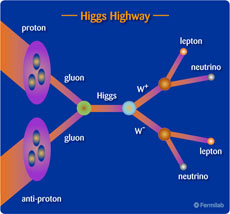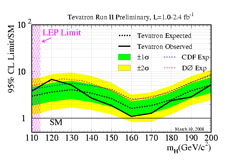The Tevatron's Higgs highway

|
| This figure illustrates one possibility for production of a Higgs boson and its subsequent decay at the Tevatron. |
Nearly all physicists know about the undiscovered Higgs boson and most Fermilab staff are aware of the eagerness with which it is sought. But not many people know much about what happens behind the scenes as Fermilab physicists blaze a trail to find this elusive particle.
Results from a combined effort by the two Tevatron collider experiments, CDF and DZero, come very close to excluding a potential Higgs boson mass of 160 GeV/c2. Those results, completed at the beginning of March, are summarized by the plot below.
CDF and DZero each have teams of physicists who focus solely on finding the Higgs boson. They know a lot about how it should fit into the Standard Model puzzle and that it gives the particles their masses. They know it should be produced predominantly by the fusion of two gluons, as shown in the illustration above. They also know the Higgs should immediately decay to the heaviest particles kinematically available. But they still need one piece of crucial information: the Higgs mass. Without it, researchers must search a wide range of potential masses and Higgs decay possibilities, each requiring its own dedicated analysis. Thankfully, they have a rough idea where to look. By combining information from all other pieces of the Standard Model, physicists expect the Higgs boson, if it exists, to have a mass below 180 GeV/c2. Searches at previous experiments have already excluded a Higgs boson with a mass below 114.4 GeV/c2.
If the Higgs mass lies in this range, the analyses designed by the Tevatron search teams' should detect it. But ultimately the researchers' efforts are limited by the amount of data collected. As the Tevatron delivers more luminosity, two things happen simultaneously. First, the potential Higgs signal grows and becomes easier to find. Second, the analyzers can improve their understanding of the data and better their search techniques. By combining the results between different analyses at each of the experiments and the results from the two experiments, they effectively double the available luminosity. Currently CDF and DZero collaborations have each collected more than 3.5 inverse femtobarns of data. By the end of 2009, the Tevatron should have delivered 7 inverse femtobarns. If the Tevatron runs in 2010, as researchers hope, the total delivered luminosity for each experiment would increase to 8.5 inverse femtobarns.
This additional data foretells an exciting future. Past experience and known improvements to the accelerator, detector performances and various analysis possibilities can help generate a road map to future results. Using this map, it
quickly becomes clear that Fermilab's road to the Higgs is paved by the contributions of everyone involved in the Tevatron physics program. Using the data expected to be delivered by the end of 2010, researchers predict they can exclude nearly the entire mass range between 115 and 180 GeV/c2. Researchers also could find evidence for a Higgs boson in both the
low and high mass regions. The potential for further improvements beyond those used in these predictions is large. No matter what happens, the teams at CDF, DZero and the Accelerator Division will keep the search for the Higgs fueled up and zooming down the Tevatron's highway to the Higgs and hopefully, into the history books.

|
| The combined Tevatron limits on the rate of production for Higgs bosons are presented as a ratio to the Standard Model prediction; a ratio of 1.0 would mean that the search is sensitive to a Higgs boson produced at the predicted rate. Though the observed values fluctuate around the limits found in the no-signal scenario, the collaborations observed no significant excess in the mass range that they searched. |
Result of the Week Archive
|